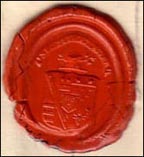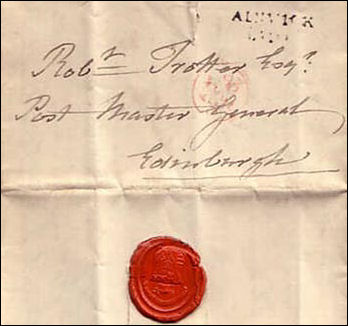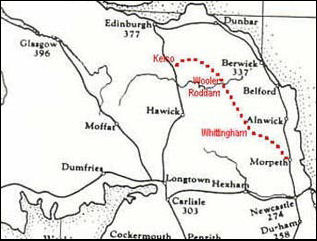[This letter graciously has been shared with the Victorian Web by Eunice and Ron Shanahan from their website, Letters from the Past.]
This letter is one of a batch of seven letters I bought in an auction lot. They are dated from 1772 to 1805, and I was intrigued as they showed Robert Trotter had begun as a Writer — or scribe— and passed his examinations, presumably to be able to practice as a Writer to the Signet. In Scotland this is a senior solicitor conducting cases in the Court of Session, and the Signet is the seal of the Court of Session. He ended up as the Postmaster General of Edinburgh. Two of the letters are from his brothers: the first from Martin in 1774 who wrote mentioning that he has heard that Robert has passed his "private Tryals" and the other was sent nearly 25 years later, in 1798, from his brother John in London, from which it is obvious that Robert is still practising as a Writer to the Signet.
 I
chose this letter from the seven because of the relevance to the postal
history. It was written by Ann Roddam, the third wife of Admiral Roddam,
and in the letter she explains why she has written it. The letter also has
a beautiful seal with the motto nec deficit alter, which
translates as 'Nor is another wanting'.
I
chose this letter from the seven because of the relevance to the postal
history. It was written by Ann Roddam, the third wife of Admiral Roddam,
and in the letter she explains why she has written it. The letter also has
a beautiful seal with the motto nec deficit alter, which
translates as 'Nor is another wanting'.
I checked this out with the Baronage Press, who advised me that it appears that she used what is probably her own seal. The arms on it may have been those of Colpitts of Killingham, for she was co-heiress to her uncle George Colpitts of Killingham: it was not the seal of Admiral Roddam.

The letter is addressed to
Robt Trotter Esqr
Postmaster General
Edinburgh
The postmarks are as follows:
- ALNWICK mileage mark, — the mileage is hard to read but looks like 320, but the Cary Listing in Alan Robertson's book shows 311. The mileages were often changed as a result of new toll roads, or diversions, so 320 could be right.
- Edinburgh Bishop Mark in red MAY 26.
So now to the contents of the letter.
Roddam Near Alnwick
24th May 1805
Sir,
I trouble you with this Letter to mention that Admiral Roddam having heard there is a wish to bring a Mail Coach either from Newcastle upon Tyne — or Morpeth, by Framlington, Whittingham, Wooler and Kelso to Scotland, he has in consequence written to the Post Masters General in London to recommend its being carried into effect; as it certainly will be a very essential Service and good to the 'centrical' parts of Scotland and Northumberland, being by many miles nearer and a very excellent Turnpike Road; except a very few miles which were omitted in the Act of Parliament originally from the Ground not then being inclosed; but the Soil being wholly gravel those few Miles might be made the finest road possible with less than the common Statute Work, and the advantage to both Countries and profit to the Proprietors of the Mail Coach would be very great; and it is a sad omission that this Rich and busy part of the Kingdom should have no Post pass thro' it, and therefore in many parts the Inhabitants have to send from 30 to 15 miles distance for Letters.
She then goes on to use the names of the nobility to press the case.
Therefore you see Sir, how much a Mail passing this Road is to be desired; about which the Admiral would himself have written to you, but tho' in excellent health, the position of sitting to write is often troublesome from the effects of a sprain he had a few years ago, and therefore Sir, he employs myself to express his wishes and that of several other Noblemen and Gentlemen; The Late Duke of Roxburgh was very desirous of it ; as (I understand ) is the Duke of Buccleigh &c &c;
I am Sir, your humble servant
Ann Roddam
 However,
as the map shows, the route, marked in red, is in between the two other main
post roads, and that is why they would have to send that distance for their letters.
The map I have used is adapted from the map in Alan Robertson's book, for the
mail coach routes in 1835, and the route is not marked on it. Either the
Postmasters General were not impressed in 1808 with the Admiral's request or
the financial aspects or perhaps it was begun, but not used, and therefore was
not kept up. Nowadays there is a perfectly good road through these towns. A letter
like this adds an insight into the workings of the Post Office in the past, and
shows how it could have developed in response to the needs of the customers.
However,
as the map shows, the route, marked in red, is in between the two other main
post roads, and that is why they would have to send that distance for their letters.
The map I have used is adapted from the map in Alan Robertson's book, for the
mail coach routes in 1835, and the route is not marked on it. Either the
Postmasters General were not impressed in 1808 with the Admiral's request or
the financial aspects or perhaps it was begun, but not used, and therefore was
not kept up. Nowadays there is a perfectly good road through these towns. A letter
like this adds an insight into the workings of the Post Office in the past, and
shows how it could have developed in response to the needs of the customers.
References
Alan W. Robertson: Great Britain Post Roads, Post Towns and Postal Rates 1635-1839
The Baronage Press
24 April 2007